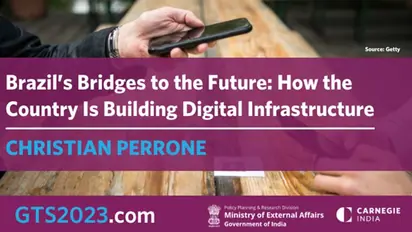Brazil’s Bridges to the Future: How the Country Is Building Digital Infrastructure

Synopsis
The summit focuses on artificial intelligence, digital public infrastructure, critical and emerging technology, national security, and more.
Author: Christian Perrone
This article is part of a series examining the geopolitics of technology, the theme of Carnegie India’s eighth Global Technology Summit (December 4–6, 2023), co-hosted with the Ministry of External Affairs, Government of India.
The summit focuses on artificial intelligence, digital public infrastructure, critical and emerging technology, national security, and more.
Click here to find out more and register. Asianet News is the media partner.
The 13.29-kilometer-long bridge over Guanabara Bay may not be among the world's longest anymore, but in the eyes of most Brazilians, it is still a colossal infrastructure project. At the same time, in terms of social transformation, other projects are surpassing it in grandeur. Rather than concrete, these new bridges are built of bytes.
Brazil is shifting its focus toward a new class of infrastructure projects—the digital kind. There are several initiatives that illustrate this trend, the most significant of which are:
- Pix, the Central Bank-led instant payment ecosystem with more than 153 million users (out of a population of 213 million) and more than 1 trillion Brazilian reais (around $200 billion) settled in transfers in 2022;
- gov.br, a public platform that facilitates identity verification and provides central and easy access to public services with more than 130 million users (nearly 80 percent of the population that is over eighteen years old); and
- DREX, an intelligent financial services system created on top of a digital currency that is scheduled to go live in 2024 and is expected to integrate different classes of assets (from stocks and debentures to even real estate) in order to lower barriers to entry and costs.
These digital projects help bridge the access gap, connecting people, businesses, and/or the government in unprecedented ways. They reduce the economic, urban-rural, and gender divides in access to goods and services, leading to development opportunities and better distribution of resources and welfare. In other words, they help raise not only the country’s GDP but also the levels of fairness and equality.
In Brazil, the implementation of Pix increased access to banking services from around 70 percent to more than 84 percent. The platform gov.br enabled more than 680 million user transactions and estimated savings of almost 3 billion Brazilian reais (almost $600 million) for the public coffers. DREX stands to democratize the availability of intelligent financial services through “smart contract technology” based on an official digital currency.
These initiatives may as well foster a more open approach toward building infrastructure for the common good. Even though they could be considered public in nature, the state ought not to shoulder all the burden of developing and maintaining these projects, and arrangements beyond the classic public-private partnerships may be forged. These may involve a variety of actors, including the private sector, civil society, academia, and international organizations, leaving the government with a coordination role.
Pix showcases some elements of the aforementioned approach. The platform was created in consultation with a wide range of stakeholders who participated in working groups and offered their views and opinions throughout the decisionmaking process. More than 200 institutions participate in the Pix Forum, making it an open space for conceptualizing the organization’s evolution. However, the Brazilian Central Bank (the government entity) plays the role of both the regulator and supervisor of the ecosystem. Thus, it not only incentivizes new use cases and further developments but also prevents harm and abuse.
Another potential trait of these new digital infrastructure projects is interoperability. The projects connect a variety of systems and organizations and thus benefit from an approach that allows them to operate in conjunction in an interoperable fashion without necessarily having to be merged or unified into a single system. The platform gov.br achieves this for public services, converging different services and systems from a broad spectrum of public administration institutions. While they maintain some of their specific characteristics in the background, for the citizen (who is the end user), they are seamlessly integrated.
Overall, the greatest payoff of the shift from physical infrastructure projects to digital ones is that the latter have the capacity to scale not only nationally but also globally. If countries like Brazil can agree on the main tenets of these projects, there would be little that can limit their potential, especially for reducing inequality. In light of this, the bridge to the future indeed appears to be digital.
Bio:
Christian Perrone holds a split-side PhD (Georgetown and UERJ) and is a Fulbright Scholar at the Georgetown Law Center, with a particular focus on international regulation and technology. He holds an LLM in international law from the University of Cambridge (UK) and a diploma in international human rights law from the European University Institute (EUI). He is a former secretary of the Inter-American Juridical Committee of the Organization of American States, where he collaborated closely with the rapporteur on privacy and data protection. He has also worked as a human rights specialist for the Inter-American Commission and the Court of Human Rights. Currently, Christian is a law partner, a public policy consultant, and the head of the rights and technology and GovTech teams at the Institute for Technology and Society, Rio de Janeiro (ITS Rio).
Disclaimer: This is a featured content